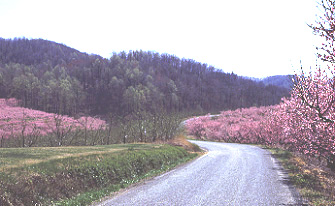
Peach Silver Mite, Aculus cornutus (Banks)
I. Introduction: The peach silver mite (PSM)
is a member of the rust mite family, with a
worldwide distribution, that was first described from peach in
Washington, D.C. in 1905.
II. Hosts: Peach, nectarine, and almond.
III. Description: Full grown PSM are light amber to yellow,
wedge-shaped, and about 7/1000
inch (0.2 mm) in length.
IV. Biology: Females overwinter on the tree in the buds and bud
scales as specialized hibernating
forms called deutogynes, which are incapable of reproducing during the
season they are formed. Early
in the spring, mites will invade the tender growing tips to feed.
Feeding and reproduction, resulting
in numerous generations, occurs on the leaf surface until hibernating
females are again produced in
the fall.
V. Injury: PSM cause two types of injury to foliage depending
upon the age of the leaf upon
which feeding occurs. Mite feeding on young leaves results in injury
referred to as "yellow spot",
which is characterized by yellow spotting and chlorosis along the
veins, with an upward longitudinal
folding of the leaf margin. The spots are circular and may be pinpoint
to more than 1/16 inch (1.5 mm)
in diameter. In severe infestations, spots coalesce resulting in leaves
with a mottled appearance. Prolonged
summer feeding on mature leaves results in a silvery or reflective
appearance that develops late in the
season just before leaf drop. This injury has been reported to reduce
fruit size and cause premature
fruit drop.
VI. Monitoring: With the aid of a hand lens, begin inspecting
leaves for PSM at bud break and
continue throughout the summer. There is no validated threshold
available for PSM, however, populations
less than 200/leaf can probably be tolerated under most conditions
without economic impact. A low to
moderate population is considered advantageous to provide an
alternative food source for mite predators
when primary prey species may be scarce.
This is taken primarily from a chapter by H. W.
Hogmire and D. F. Polk on peach indirect pests,
reprinted with permission from Mid-Atlantic Orchard Monitoring Guide,
published
by
NRAES, 152 Riley-Robb Hall, Ithaca, New York 14853-5701. (607)
255-7654.
Back to Virginia
Peach
page
Back to Virginia Fruit
Page
